You are using an out of date browser. It may not display this or other websites correctly.
You should upgrade or use an alternative browser.
You should upgrade or use an alternative browser.
Elysian Acoustics Annihilator 2023
- Added by freeryder05
- Create date
grumpy213
100+ Head-Fier
Pros: Energetic and exciting sound signature
Forward and excellent treble
Wonderful staging
Excellent detail retrieval
Forward and excellent treble
Wonderful staging
Excellent detail retrieval
Cons: Bass could be tighter
Mids are a little too recessed
Mids are a little too recessed
Preamble

Many thanks to @Yifang for lending me his personal unit for this review.
There are some items in this hobby of audio that become something of lore. These items seem to transcend their raison d’etre of producing sound into your earholes and become something that essentially dominates the hobby in terms of conversation and benchmarking. From the IEMs such as the Moondrop Chu causing an arms race amongst Chi-Fi manufacturers of a race to the bottom of the price bracket, the Moondrop Blessing 2 Dusk becoming the defacto choice in its price bracket, the Campfire Andromeda 2020 becoming the IEM to have for a ‘holographic stage’ and so on. Today’s review concerns an IEM that has garnered significant praise and attention from reviewers and casual audio enjoyers alike at a rather eyewatering price bracket. The Elysian Annihilator has become renowned for its energetic and engaging sound signature combined with what some have termed ‘best in class treble’. But does the myth match the reality?
The Factual Stuff
Fashioned by Lee from Elysian Audio, the Annihilator consists of a 7 driver set up consisting of 1 Fostex dynamic driver, 2 electrostatic tweeters and 4 balanced armatures put together by a four-way crossover.Proprietary technologies (and their sometimes hilarious names) are rather common in the IEM space and Elysian is no different with its DiVe Pass System for Dynamic Driver which promises controlled bass and zero driver flex and a 3D AccuPost System to provide staging.
This all comes together in a laquer finished resin housing adorned with your choice of a polished gold or silver coloured face plate or a brushed titanium faceplate for a premium.
The Annihilator comes with a number of accessories including the Liquid Links Martini cable with the requisite Pentaconn Ear connector for the Annihilator.
The Anni is priced at $3000 USD.
The Opinion Stuff

Sound
This review is conducted with the Anni with Spinfit CP145 eartips connected to a Luxury & Precision P6 Pro.Bass
TL;DR: The Anni provide a detailed and punchy mid-bass experience without overwhelming the tonal balance, ideal for listeners who appreciate nuanced bass but may disappoint those seeking more aggressive bass-heavy tunes.Low-end oomph is hardly the defining feature of the Anni in that it does not seek to overwhelm you in any regard. The Foster DD does a rather good job of maintaining a speedy and detailed rendition of bass with fast-paced basslines being reproduced with gusto. The quantity of bass is also quite good, it doesn’t overwhelm the tonal balance of the Anni nor does it sit so far behind that it becomes an afterthought. Sub-bass extention is good but exactly excellent and the mid-bass punchiness of the Anni lends itself to an enjoyable listening experience. I believe that the focus here is a mid-bass tuning experience that provides the Anni with an excellent sense of pace and rhythm.
Booming basslines on songs such as “THE PLAN” from the TENET soundtrack do not jump out at you like they do on more aggressively tuned IEMs and so there is a disappointment factor in this regard but for those of you who are not bass-heads, I believe that the Anni’s conservative tuning may be beneficial.
"The Calling (Da Tweekaz Remix)" by TheFatRAt is an energetic hardstyle song with a slow build-up to an extremely energetic and fast-paced bassline after the drop and the Anni does an excellent job of keeping and retaining a sense of detail and texture despite the business of the production.
“Before Dawn” by Slander provides a booming and consistent bassline that is focused on mid-bass excellence and the Anni shines here, keeping up with the pace and providing me with a wonderfully detailed and punchy bass experience that does not detract from the rest of the song, but rather adds to the experience.
Overall, the Anni’s lower-end renditions is not the killer app that provides its claim to fame. The Anni’s focus seems to be more on the mid-bass and sub-bass enjoyers who want a greater ‘physicality’ to their music may be disappointed. These quantities sought are hugely subjective and in terms of technical performance of bass, the Anni is able to provide you with a speedy, resolving and detailed rendition of the low-end that helps generate a sense of pace and rhythm to keep your toes tapping along with the music.
Mids
TL;DR: Anni offers a midrange performance that enhances male and female vocals with warmth and presence, delivering an energetic and detailed listening experience.Moving to the midrange performance of the Anni, the aforementioned mid-bass punchiness imbues a subtle sense of warmth to the lower-mids that is quite good. There is not bleed here by any means but a slight heightening of note weight and a swelling of euphonia with male vocalists. Crooning RNB in the form of “Water Runs Dry (Strat Mix)” by Boyz II Men is a tremendously engaging experience with a more guttural quality to the vocals that envelops the listener.
Female singers in the upper mids/treble region present in a heightened manner, the tuning here seems to bring them to the front of the stage creating an engaging listening experience that tickles the ears…perhaps a little too much. More sibilance inducing songs in the form of “34+35” by Ariana Grande and “4 walls” by f(x) have a lot of sss sounds from female vocalists in a higher register and the result is a slight fatigue factor here.
More relaxed renditions such as “Billie Bossa Nova” by Billie Eilish avoids the aforementioned sibilance by sitting in a lower register with less of a heady voice and the result is a tremendously engaging experience that balances detail and enjoyability.
Combining the two in a duet such as "2easy" by Nive and Heize, presents a well balanced combination of the two. There appears to be no favourtism with the Anni but if I really had to put money on it, I’d say that female voalists are slightly more forward in the mix. “Godfrey, First Elden Lord” from the Dark Souls OST combines booming drums, strings, horns and a choir to give that does a great job of depicting the peril of a boss fight in a video game and the Anni resolves it in spades. Strings render and convey great harrowing peril through crescendos and, horns present in a manner that is befitting their bombastic nature. Instrumentalisation focused music such as orchestral pieces sound similarly excellent.
Overall, the mids are not a warm and enveloping experience but rather a harder nosed, edgier rendition of instruments and vocals. This may disappoint some, but the energy of its mid-range rendition is something that may be seen as beneficial for some listeners.
Treble
TL;DR: Anni's treble response provides a crisp, sparkly, and engaging listening experience with well-balanced high frequencies that enhance percussion and synth elements without causing discomfort or fatigue.Moving on to the most hyped element of the Anni, the treble response has been praised extensively by many people. Noting that preconceived expectation, I have to say that treble is usually the last thing that really jumps out to me. Call it deafness or just a lack of experience, treble is something that is only really apparent to me when it is missing or is overly spicy.
With all that being said, the Anni provides me with a nicely sparkly and almost crystalline experience with instruments residing in this region. Hi-hats, cymbals, wind chimes and all kinds of percussion sound crisp, engaging and without sibilance or harshness. Synth stabs and crescendos of high pitched EDM are well placed in the tonal balance of the Anni, it presents in a manner that tickles the eardrums without deafening me. There is a sense of speed here where percussion doesn't seem to step one each other's toes and is reproduced in a very clear and coherent manner.
There are definitely moments with the Anni wherein the hairs on the back of my neck stand-up but I am not discomforted by long listening sessions with it. Airiness is rather good and seems to open up the stage of the Anni, not in a manner that renders it diffuse and ineffectual but there is an ease in staging that makes certain portions of the FR curve more easily discernible. As mentioned earlier, upper mids feel a little hot from time-to-time but this is not a huge deal for me as I note that I am generally sensitive to this. "Exigece" by Koan Sound presents with a wonderful mix of both orchestral instrumentalization and the somewhat grating synths of EDM production, to which the Anni handles with gusto presenting the low-end, mids and the treble with an energy that is addicting to listen to.
Overall, the treble on the Anni has made me, a very deaf man (joking but maybe not), an appreciator of the higher-end region of the FR curve. Treble continued to jump out to me throughout listening experiences and I sought out percussion, piercing EDM synths and the like in order to feed my desire to listen to the Anni's wonderful reproduction.
Technicalities
TL;DR: The Anni excels technically with its spacious and energetic staging, excellent detail retrieval, and dynamic volume swings, offering a grand and engaging listening experience across various music genres.Moving on to the technical performance of the Anni, the staging of the Anni is rather excellent. With a sense of grandness with the width, depth and even height of its staging, the Anni performs well with a range of genres. On “One Winged Angel” by Nobuo Uematsu, the rendition of a music hall is almost faithful to the real life thing. There are definitely wider and more holographic stages out there, but they also have a tendency to feel more diffuse and seem to disconnect you with the music. This is not the case with the Anni where everything seems immediate and energetic enough within the stage.
Outside of staging, detail retrieval and resolution is also excellent with its aforementioned staging chops. It presents music in a layered and well articulated manner within the stage, presenting you with detail to pick out at your leisure. Dynamic swings of volume such as a sudden crescendo present with a sense of scale that is quite enjoyable to listen to.
Overall, the Anni is an excellent technical performer, providing you with great energy within a spacious stage, resulting in a grand and engaging listening experience.
Overall
The Anni is an energetic and exciting listen, with a U-shaped sound signature, it seeks to enthrall you with low-end power and upper-end sparkle in a manner that is extremely satisfying to listen to. Those who enjoy mid-forward IEMs and more acoustically focused music may want to look elsewhere but for the thrill seeking lover of EDM, or pop, the Anni presents music in a manner that is extremely enjoyable.Comparisons
vs Unique Melody Multiverse Mentor
TL;DR: The UM MM lacks the Anni's dynamic driver and visceral low-end but offers a warmer, more intimate sound with a unique holographic soundstage, presenting a laid-back alternative to the Anni's energetic and crisp listening experience.
The UM MM is lacking a DD compared to the Anni and the result in the low-end is a bit predictable. The MM cannot match the sheer displacement of the Anni and lacks the visceral physicality of the low-end. That is not to say it is a slouch in this regard, with a more mid-bass focused presentation, it still satisfies my need for punch and pace but it cannot replicate the throaty sub-bass of the Anni. The mids are were these IEMs seem to diverge, with the MM taking a much warmer and mid-forward tilt. The result of this is a more intimate vocal that is honeyed in its reproduction whereas the Anni sounds slightly drier in its rendition. This is not an L to the Anni but more so a different flavour.
The treble continues this divergence with the Anni presenting with far greater energy and crispness in this region. The MM, whilst not bad in this region, doesn’t have the same level of engagement, lacking the edginess that the Anni possesses.
In terms of technical performance, the MM has the benefit (or perhaps curse) of a Bone Conducting Driver (BCD), the result of which is a holographic sound stage that extends past the confines of your head and layers music in a unique way. It therefore has a more expansive stage but certain notes within this stage do not have the same energy and clarity as the Anni. Resolution and detail retrieval on first listen is an Anni win but this is more due to the tuning and I do not feel that the MM is far behind on more critical listens.
Overall, I believe the energy of the Anni lends itself to favour more genres and seeks to demand your attention. The MM presents in a more laid-back and warm manner in order to envelop you the music rather than command your attention. This is a matter of different strokes for different folks and I would welcome the two into a collection as complementary rather than as competitors.
vs Campfire Supermoon
TL;DR: The cheaper Supermoon, with its V/U-shaped tuning, offers dynamic bass and treble but falls short of the Anni’s more balanced and natural sound, superior technical performance, and overall ease of listening.
This is a far cheaper IEM but there is a slight alignment in energy and tuning in that the Supermoon seeks to adopt a V/U-shaped tuning to highlight lower-end oomph and upper-end energy. The Anni unfortunately (or perhaps fortunately) trumps the Supermoon conclusively apart from the speediness of the Supermoon’s presentation. Low-end punch and physicality leans towards the Anni as the Supermoon’s ultra-fast rendition of basslines, whilst uniquely enjoyable is less punchy. Mid-range timbre on the Anni is superior as the Supermoon leans slightly too thin and lacking in naturalness and treble energy, whilst impressive on the Supermoon can be a little too overwhelming over time. The Supermoon requires a cable roll and some specific tips in my mind whereas the Anni is excellent out of the box.
Technical performance on the Anni trumps the Supermoon in terms of stage space, layering and overall resolution. The Supermoon seems to lean on a more energetic upper-end and a drier rendition of notes to heighten a sense of detail but longer-listening sessions yield a win for Anni.
The Supermoon, whilst quite good (when on sale) cannot match the tuning balance of Anni and its overall ease of listening. Those who demand speed from their IEMs may turn to the Supermoon but for everything else, I would much prefer the Anni.
Synergy
One thought coming to my mind here namely lessons learnt after multiple DAPs, DACs and Amps plus headphones and IEMs is synergy! Hoping for the one and only holy grail Setup is maybe just a nice wish unless buying according synergy transducers and I don't believe even the best sources are an exception here. There's a reason why people are having multiple devices in parallel or reducing inventory and keeping only the ones with right synergy.Luxury & Precision P6 Pro (P6P)
The majority of this review was conducted on the P6 Pro and for good reason, the P6P provides a smooth and rounded rendition of sound but without blunting the resolution and detail retrieval of the Anni. It presents in a manner that is naturally timbred, easy to listen to and wonderful in terms of technical performance. There is little influence on the tuning and the nature of the Anni is retained. The P6P does blunt the energy of the Anni somewhat if used in NOS mode but for the most part, this presents a wonderful pairing that I can recommend wholeheartedly.Shanling M6 Ultra (M6U)
The M6U provides a slight u-shape tuning with an injection of warmth and spiciness in the upper regions. This is less of a neutral source compared to the P6P but has some characteristics in terms of smoothness and a rounding of notes. There is an imbuing of note weight with the M6U that makes the Anni punchier and more in your face with its presentation but this does also increase the fatigue with longer-listening periods. Technicalities are retained for the most part and there is a slight uptick in sibilance with certain songs but overall, I believe the M6U leans into the strengths of the Anni without overindulging. This is a good choice if you do not wish for mids to be brought forward in the mix.Chord Mojo 2
The Mojo 2 is a slight warm-neutral source that has a harder edged note reproduction to heighten detail and resolution. The Mojo 2 does a decent job with the Anni but there seems to be a slight blunting of dynamic range. This is a fairly inoffensive source pairing but with the benefit of DSP, I was able to heighten staging through crossfeed and alter the FR curve to better suit my preferences. Overall, its a fine source but nothing too amazing.Value & Quality of Life
The Anni was an object of desire of mine for a long period of time. Priced at $3000 USD, the pricetag is a bit of a hard ask for many audiophiles but for those who are willing to spend are rewarded with an energetic and fun-infused listening experience. This price range holds some key competitors and whilst the Anni is not a slam-dunk please everyone choice, its energy and treble performance creates a wholly enjoyable listening experience. I do not feel remiss stating that the Anni is worth the dollar you pay for it so long as you don’t expect the world’s best bass nor a mid-forward approach. Expect a respectable low-end and a great upper-end combined with a wonderful technical performer and the Anni is well worth it.The shells are rather large but for my particular ear shape they feel right at home with no fatigue over time. I would have liked something a little more sculpted for the concha but overall, I do not think these would be too cumbersome unless you had a smaller ear.
The nozzles are rather large and whilst this was fine with me, it will prove cumbersome for smaller eared individuals. The P-Ear connector is the bane of many a cable collector but I am quite partial to its adoption as I feel it is far better than MMCX and has greater manoeuvrability than 2-pin.
The Anni requires a fairly powerful source and seems to scale well with additional power. Requiring high-gain on nearly all my sources and a rather healthy amount of volume, the Anni does even better when powered by an external amp such my Sound Tiger Sinfonia. The scaling of the Anni bodes well for more discerning audiophiles who have a number of sources but I do not feel it will be that great for more minimal setups such as dongles.
The Anni is a handmade item and therefore, there is a bit of waiting period for them, with vendors usually taking pre-orders before they are made. This is a bit of a frustrating process but Lee is definitely speeding up with the production of Anni but this is something to note should you be running out to buy one.
And as with any handmade item, there is a tendency to be some issues or imperfections but I have only heard limited experiences with this and I would be confident in purchasing one.

Conclusion
Energy, engagement and excitement are what I would use to describe the Anni. It is not a specialist IEM but its tonal colour is heightened when thrown EDM and pop music. Technical performance is excellent and doesn’t leave me wanting for anything else but its deficiencies in the mid-range ultimately led me to the UM MM. This is less of an indictment of the Anni but rather a highlighting of the need to understand your library and the suitability of your IEM to your music. With that being said, it was much longer after purchasing the UM MM that I began musing about the Anni as a complementary IEM in the collection. It commands your attention and leaves an indelible mark, its treble wonderful, its stage grand and its detail impeccable. Anni is one for the ages, and I feel is worthy of its mythical status as a must-have IEM.
View previous replies…
GiullianSN
Legend!
dleblanc343
Great review man!
Jaytiss
500+ Head-Fier
Pros: Fantastic treble
Bass is rumbly with the shell
Best EST implementation I've heard
Hassle Free iem, no switches or eq needed
Wonderful Vocals
Great iem that doesn't disappoint in build quality or appearance.
Bass is rumbly with the shell
Best EST implementation I've heard
Hassle Free iem, no switches or eq needed
Wonderful Vocals
Great iem that doesn't disappoint in build quality or appearance.
Cons: Treble can be a little much
Has a bit of a studio-feeling sound rather than a concert
Cable is hard to swap and is a 4.4mm
Cable can bother my ears at times.
Has a bit of a studio-feeling sound rather than a concert
Cable is hard to swap and is a 4.4mm
Cable can bother my ears at times.

I love the build quality of it, and it fits in my ear perfectly. The shell is world-class. I was able to demo this iem first at Can Jam So Cal 2023 and loved it there.
The Tip selection is a little bit lackluster as you only get one set of W1s. The packaging is a little boring given the price of the iem as well, but overall it is a strong iem.
The included case is fairly boring. So overall the packaging doesn't feel pristine, and the money is in the sound not the packaging.
The Cable is world-class and is fun to play with while listening to music. It has a beautiful shimmer. I've tried to cable swap and keep going back to the original cable.
BASS
The bass response is really enjoyable and underrated. It rumbles and sounds good in the ear in certain tracks. It's really fun, the shell will vibrate at times. Sometimes I wish for more bass, but it's very strong and worthy for most music.
Mids
The mids are perfect and faultless. They sound correct and clean to my ears. Vocals come up well and it just pleasant.
Trebble
It can be fatiguing and a little bit much at times but sounds overall really strong. I feel it shines with details and has a great lovely sound.
Timbre
It's perfect, a little sweet. It sounds great on anything that I throw at it.
Conclusion
I am in awe, and in love. It's a fully great set. I have a little bit of time in between a few structured reviews and thought that I'd drop a review and a YouTube video on a personal set. It's been on my desk for a long time. I've tested and tried many iems over my journey in the last year. This is one that always impresses me, even in its simplicity and clarity and it's just the right fun factor. I can't say anything bad, but limitless Extension. This iem is stellar and gets my recommendation for all those who are interested in it despite its price.
Quick Summary video if anyone is interested.
o0genesis0o
I want to meet Lee of Elysian one day just to see how his ears look like. Don't understand why he insists on supplying W1 for all of his creations whilst a deeper fit just works better.
btwine
100+ Head-Fier
Pros: Peerless treble - Wow factor
Solid bass performance
Excellent technicals, particularly resolution, transients, timbre, dynamics
All-rounder, plays great with any music genre
Beguiling vocals and acoustic instrument portrayals
Great value (even at a $3K price)
Solid bass performance
Excellent technicals, particularly resolution, transients, timbre, dynamics
All-rounder, plays great with any music genre
Beguiling vocals and acoustic instrument portrayals
Great value (even at a $3K price)
Cons: Bass a bit wooly compared to Fei Wan
Uncomfortable fit for some ear anatomies
Uncomfortable fit for some ear anatomies
This review - really a set of impressions and comparisons - is cross-posted from The Watercooler

After spending this week getting acquainted with Elysian Annihilator 23 and letting it burn in for 20 hours, today I started to compare it with the Aroma Fei Wan. Two IEMs that share many similarities! Although Fei Wan is about 50% more in retail price, amazingly the Annihilator 23 compares with it very well. And as @Rockwell75 has pointed out, they both feature the Asian/Eastern sound profile, a more top-down approach and yet with strong lower ends. Here are my impressions of the two side-by-side.
Chains:
N30 (hyper/classic tube)>Venom>Anni>Divinus Velvet
M9+>1950s Shielding>Fei Wan>Azla Sedna Max
Music:
A mix of classic rock, modern rock, folk rock, pop, and jazz vocal.
Impressions:
Annihilator 23:
On its own merits, what a terrific IEM in so many ways. I agree with what some others have said here, that it is more than a treble specialist. Anything I threw at it from my library sounded great.
In terms of fit, Anni 23 is not very comfortable for my ears. This is due to its bulk, wide nozzle and its angle for my ear anatomy. Even after tip-rolling to get to the best option (Velvets), I need a break after no more than several hours of listening. This is a bummer and is often a reason I rule out whether an IEM has a spot on my roster.
For appearance, the Anni 23 Ti is a gorgeous piece, as beautiful as the gold edition, and rivalling all other great looking IEMs I have seen in person. And, at the end of the day I don't really care about that. When it's in my ears, I can’t see it. But I can feel it and hear it.
As for the most important aspect, the sound:
I find Anni 23 has a relatively U shaped profile, with mids a bit more recessed than Fei Wan's.
With its DDs, the sub bass is good not great, as is the mid bass. It has a medium-plus amount of bass quantity, though much less would not be acceptable. By comparison to Fei Wan, Anni's bass quality sounds a bit pillowy and woolly. But if I hadn't heard FW, I wouldn't have had quite that impression. On its own, Anni’s bass is reasonably satisfying, and complements the treble in particular in a balanced manner.
Mids are well articulated but not as prominent as its high and low ends. On some more complex songs with lots of instrumentation and singing, I couldn’t hear the male vocals as much as I do on the Fei Wan in the same case. Acoustic instruments sound fantastic on Anni, with such great timbre and transients, maybe better than any IEM I have heard. I hear this in particular on Humble Pie’s “Sucking on the Sweet Weed“, as I’ve never heard it before, just wow. Anni has relatively no upper mids energy, as opposed to Fei Wan.
The treble is better than any I have heard. It is smooth, crisp, airy, rich, so many great qualities I had never heard in treble to this degree of dazzling until now. Higher-pitched female vocals like Sarah Jarosz and Jenny Lewis in particular sound beguiling. As fantastic as Fei Wan’s treble is, Anni’s treble is a bit of a step up. With all that it has going on in the high end, I am really pleased to find zero sibilance. And I would not describe Anni to be bright - it all sounds just right, from the top down. It is not fatiguing.
Both sets have excellent technicals: details, transients, dynamics, and staging in particular. Anni's resolution is on par with Fei Wan. Dynamics are very slightly behind FW. And staging is narrower and shallower than FW. I find Anni to have a cleaner (though not clinical) sound than FW. Both sets provide an emotive experience, with Anni’s being more relatively peaceful. Anni’s signature is warm but FW’s is warmer, thanks to its much stronger bass.
Just listening to Anni for much of the week, I found it often to be an exciting, activating listen, but generally scalable to the mood of a song. Compared to Fei Wan, Anni 23 is relatively calmer, and listenable for longer periods.
Fei Wan:
It is like Anni 23 on steroids. The sound profiles of both are similar, with FW having much more intensified qualities.
I have the universal stock Fei Wan, and its yellow and gold appearance is neutral for me, not as ugly as some have characterized it. I don't really care what it looks like, as long as the fit and sound work, which is the case.
For fit, Fei Wan is the most comfortable IEM I have ever used. I could have it in all day and wouldn't hardly notice it is there. I think the build is very good, more premium than others have described it.
I find FW’s sound profile to be U-shaped (almost W-shaped), even though many say it is V-shaped - I do not hear the mids to be very recessed. On songs with male vocals, they do not recede behind the rest of the band. Anni’s mids recede a bit more.
Fei Wan’s quantity and quality of bass is among the best I have ever heard, better in my mind than other DD class leaders like Xe6, Rn6, EVO, EXT, Maestro SE, and maybe even Trifecta, given how much more speed Fei Wan showcases in its bass. The only comparable fast and tactile sub bass I have heard is Grand Maestro, which unfortunately for me was so uncomfortable (universal model) that it was unusable.
On more balanced songs, Fei Wan’s bass is maybe the best I have heard as part of the whole experience. With songs featuring lots of lower end, like Yes “Starship Troopers”, Beatles “Come Together”, and Daft Punk “Get Lucky”, it is an incredible sound. Loads of gut-punch and thwack. Fei Wan’s bass provides a visceral, vivid, and satisfying experience. It rarely creeps up into the mids, maintaining a discrete and still coherent mix. On songs where there is a much warmer tone and deeply heavy resonant bass sound, like The Weeknd "I Can't Feel My Face" and Roisin Murphy "We Got Together", the high end is never overwhelmed.
Back to the comparison here, Fei Wan's bass is more tactile than Anni's. FW has much more sub bass than Anni. And its mid bass is detailed and not at all woolly like Anni's is relatively.
FW has incredible timbre. Acoustic instruments sound realer than any IEM I have heard outside of Trifecta. Voices are not only crisp and well delineated, I can hear a bit more realism to them than on Anni. Deeper male voices in particular like Jose James and Gregory Porter sound rich and evocative on Fei Wan.
FW has a fair amount of upper mid energy, as many have commented on. It can be fatiguing without the right setup. I have mitigated this verve with source, cable and tips to a large degree. FW sounds especially rich and smoothed over a bit on the M9+. But after listening to Anni for awhile, switching to Fei Wan, the burst of higher end intensity is palpable, for better or worse, depending on my mood and expectations of musical experience in that moment. At times it can feel like I am careening down a highway at night and the brakes go out. A white knuckle experience.
FW has excellent treble, maybe 90% the quality of Anni's. Relative to Anni 23, Fei Wan is brighter, though on its own merits I wouldn’t call it bright, more like glowing, since there is no sibilance to be found on Fei Wan either, try as I might to find it on test songs.
While both sets have top-shelf technicals, I find that FW is a small but noticeable level-up on all, except transients, where Anni has a slight edge. Fei Wan on the whole sounds bigger, more spacious. Relatively, Anni sounds like I am listening to a performance in an intimate club setting with minimal amplification, whereas with Fei Wan I am at a much larger concert venue with powerful amplification. Listening to David Crosby's "Woodstock (Live at the Capitol Theatre)" and Diana Krall's "Lets Fall In Love" particularly illustrates this distinction. I find FW to have more of an analogue sound than Anni. Both leave me with an emotive experience, with FW’s featuring more intensity of emotion. FW’s signature is warmer.
Overall, Fei Wan provides more of a dynamic and thrilling (and after several hours exhausting) listening experience than Anni 23. FW is not as scalable as Anni, though almost all of my library still sounds very good to great with it.
The bottom line:
Both Annihilator 23 and Fei Wan are superb, and different enough that they could each have a place on a great roster of IEMs, with Anni 23 being to me more of the all-rounder and FW being more of the fun joy-ride set. But the experience is more than sound quality, and for my roster, I need to decide whether Anni’s fit problems are worth living with. Considering that factor, if I had to choose between the two, Fei Wan would be the keeper, an outstanding one at that.


After spending this week getting acquainted with Elysian Annihilator 23 and letting it burn in for 20 hours, today I started to compare it with the Aroma Fei Wan. Two IEMs that share many similarities! Although Fei Wan is about 50% more in retail price, amazingly the Annihilator 23 compares with it very well. And as @Rockwell75 has pointed out, they both feature the Asian/Eastern sound profile, a more top-down approach and yet with strong lower ends. Here are my impressions of the two side-by-side.
Chains:
N30 (hyper/classic tube)>Venom>Anni>Divinus Velvet
M9+>1950s Shielding>Fei Wan>Azla Sedna Max
Music:
A mix of classic rock, modern rock, folk rock, pop, and jazz vocal.
Impressions:
Annihilator 23:
On its own merits, what a terrific IEM in so many ways. I agree with what some others have said here, that it is more than a treble specialist. Anything I threw at it from my library sounded great.
In terms of fit, Anni 23 is not very comfortable for my ears. This is due to its bulk, wide nozzle and its angle for my ear anatomy. Even after tip-rolling to get to the best option (Velvets), I need a break after no more than several hours of listening. This is a bummer and is often a reason I rule out whether an IEM has a spot on my roster.
For appearance, the Anni 23 Ti is a gorgeous piece, as beautiful as the gold edition, and rivalling all other great looking IEMs I have seen in person. And, at the end of the day I don't really care about that. When it's in my ears, I can’t see it. But I can feel it and hear it.
As for the most important aspect, the sound:
I find Anni 23 has a relatively U shaped profile, with mids a bit more recessed than Fei Wan's.
With its DDs, the sub bass is good not great, as is the mid bass. It has a medium-plus amount of bass quantity, though much less would not be acceptable. By comparison to Fei Wan, Anni's bass quality sounds a bit pillowy and woolly. But if I hadn't heard FW, I wouldn't have had quite that impression. On its own, Anni’s bass is reasonably satisfying, and complements the treble in particular in a balanced manner.
Mids are well articulated but not as prominent as its high and low ends. On some more complex songs with lots of instrumentation and singing, I couldn’t hear the male vocals as much as I do on the Fei Wan in the same case. Acoustic instruments sound fantastic on Anni, with such great timbre and transients, maybe better than any IEM I have heard. I hear this in particular on Humble Pie’s “Sucking on the Sweet Weed“, as I’ve never heard it before, just wow. Anni has relatively no upper mids energy, as opposed to Fei Wan.
The treble is better than any I have heard. It is smooth, crisp, airy, rich, so many great qualities I had never heard in treble to this degree of dazzling until now. Higher-pitched female vocals like Sarah Jarosz and Jenny Lewis in particular sound beguiling. As fantastic as Fei Wan’s treble is, Anni’s treble is a bit of a step up. With all that it has going on in the high end, I am really pleased to find zero sibilance. And I would not describe Anni to be bright - it all sounds just right, from the top down. It is not fatiguing.
Both sets have excellent technicals: details, transients, dynamics, and staging in particular. Anni's resolution is on par with Fei Wan. Dynamics are very slightly behind FW. And staging is narrower and shallower than FW. I find Anni to have a cleaner (though not clinical) sound than FW. Both sets provide an emotive experience, with Anni’s being more relatively peaceful. Anni’s signature is warm but FW’s is warmer, thanks to its much stronger bass.
Just listening to Anni for much of the week, I found it often to be an exciting, activating listen, but generally scalable to the mood of a song. Compared to Fei Wan, Anni 23 is relatively calmer, and listenable for longer periods.
Fei Wan:
It is like Anni 23 on steroids. The sound profiles of both are similar, with FW having much more intensified qualities.
I have the universal stock Fei Wan, and its yellow and gold appearance is neutral for me, not as ugly as some have characterized it. I don't really care what it looks like, as long as the fit and sound work, which is the case.
For fit, Fei Wan is the most comfortable IEM I have ever used. I could have it in all day and wouldn't hardly notice it is there. I think the build is very good, more premium than others have described it.
I find FW’s sound profile to be U-shaped (almost W-shaped), even though many say it is V-shaped - I do not hear the mids to be very recessed. On songs with male vocals, they do not recede behind the rest of the band. Anni’s mids recede a bit more.
Fei Wan’s quantity and quality of bass is among the best I have ever heard, better in my mind than other DD class leaders like Xe6, Rn6, EVO, EXT, Maestro SE, and maybe even Trifecta, given how much more speed Fei Wan showcases in its bass. The only comparable fast and tactile sub bass I have heard is Grand Maestro, which unfortunately for me was so uncomfortable (universal model) that it was unusable.
On more balanced songs, Fei Wan’s bass is maybe the best I have heard as part of the whole experience. With songs featuring lots of lower end, like Yes “Starship Troopers”, Beatles “Come Together”, and Daft Punk “Get Lucky”, it is an incredible sound. Loads of gut-punch and thwack. Fei Wan’s bass provides a visceral, vivid, and satisfying experience. It rarely creeps up into the mids, maintaining a discrete and still coherent mix. On songs where there is a much warmer tone and deeply heavy resonant bass sound, like The Weeknd "I Can't Feel My Face" and Roisin Murphy "We Got Together", the high end is never overwhelmed.
Back to the comparison here, Fei Wan's bass is more tactile than Anni's. FW has much more sub bass than Anni. And its mid bass is detailed and not at all woolly like Anni's is relatively.
FW has incredible timbre. Acoustic instruments sound realer than any IEM I have heard outside of Trifecta. Voices are not only crisp and well delineated, I can hear a bit more realism to them than on Anni. Deeper male voices in particular like Jose James and Gregory Porter sound rich and evocative on Fei Wan.
FW has a fair amount of upper mid energy, as many have commented on. It can be fatiguing without the right setup. I have mitigated this verve with source, cable and tips to a large degree. FW sounds especially rich and smoothed over a bit on the M9+. But after listening to Anni for awhile, switching to Fei Wan, the burst of higher end intensity is palpable, for better or worse, depending on my mood and expectations of musical experience in that moment. At times it can feel like I am careening down a highway at night and the brakes go out. A white knuckle experience.
FW has excellent treble, maybe 90% the quality of Anni's. Relative to Anni 23, Fei Wan is brighter, though on its own merits I wouldn’t call it bright, more like glowing, since there is no sibilance to be found on Fei Wan either, try as I might to find it on test songs.
While both sets have top-shelf technicals, I find that FW is a small but noticeable level-up on all, except transients, where Anni has a slight edge. Fei Wan on the whole sounds bigger, more spacious. Relatively, Anni sounds like I am listening to a performance in an intimate club setting with minimal amplification, whereas with Fei Wan I am at a much larger concert venue with powerful amplification. Listening to David Crosby's "Woodstock (Live at the Capitol Theatre)" and Diana Krall's "Lets Fall In Love" particularly illustrates this distinction. I find FW to have more of an analogue sound than Anni. Both leave me with an emotive experience, with FW’s featuring more intensity of emotion. FW’s signature is warmer.
Overall, Fei Wan provides more of a dynamic and thrilling (and after several hours exhausting) listening experience than Anni 23. FW is not as scalable as Anni, though almost all of my library still sounds very good to great with it.
The bottom line:
Both Annihilator 23 and Fei Wan are superb, and different enough that they could each have a place on a great roster of IEMs, with Anni 23 being to me more of the all-rounder and FW being more of the fun joy-ride set. But the experience is more than sound quality, and for my roster, I need to decide whether Anni’s fit problems are worth living with. Considering that factor, if I had to choose between the two, Fei Wan would be the keeper, an outstanding one at that.

Last edited:
btwine
In fact I bought the largest set (size large) of Baroques and they were too small for my apparently large ears. It's a bummer because indeed the Baroques are super plush. And apparently really good for bass improvement.
galthepal
Oh dang super unfortunate! Great review though and was wondering how the Anni compared to the Fei Wan, thanks for doing it!
vikinguy
“I need a break after no more than several hours of listening”
Wow! I don’t recall the last time I had a set in for several hours! Makes me happy that you love music that much!
Wow! I don’t recall the last time I had a set in for several hours! Makes me happy that you love music that much!
Smirk 24
500+ Head-Fier
Pros: - Exceptional resolution
- World-class treble
- Great dynamics
- Fun, engaging listen
- World-class treble
- Great dynamics
- Fun, engaging listen
Cons: - Prohibitive cost
- Lack of bass texturing (for price)
- Average imaging (for price)
- Long wait time
- Lack of bass texturing (for price)
- Average imaging (for price)
- Long wait time
Introduction
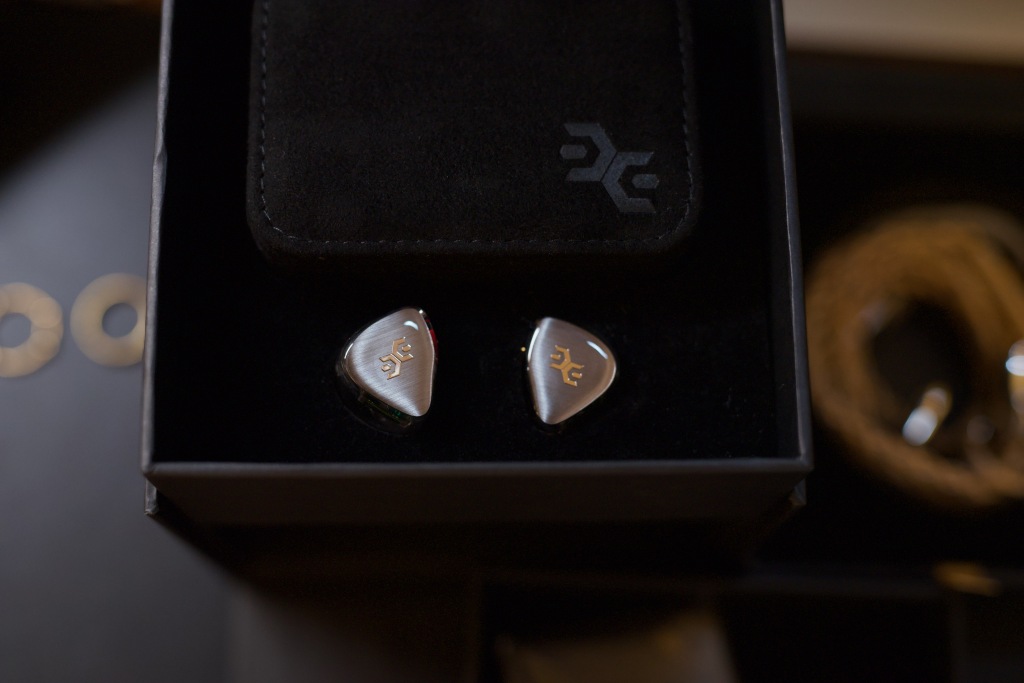
When the original Annihilator was released back in 2021, it was relegated to obscurity, that is, before word of mouth spread about how good it actually was, and how exceedingly difficult it was to get ears on a pair.
In the years that followed, the Annihilator has seen a meteoric rise to an almost unicorn-like status that it still enjoys in the present day.
The subject of today's review is the Annihilator 2023, the latest iteration, which features improvements including updates to its crossover circuit and internal wiring.
According to Lee, the internal wiring now uses different materials for each of the low, middle, and high frequencies contributing to an overall smoother presentation.
The Elysian Annihilator used for this review is a personal unit. All of my IEM reviews are reviews of personal units unless otherwise specified.
Unboxing
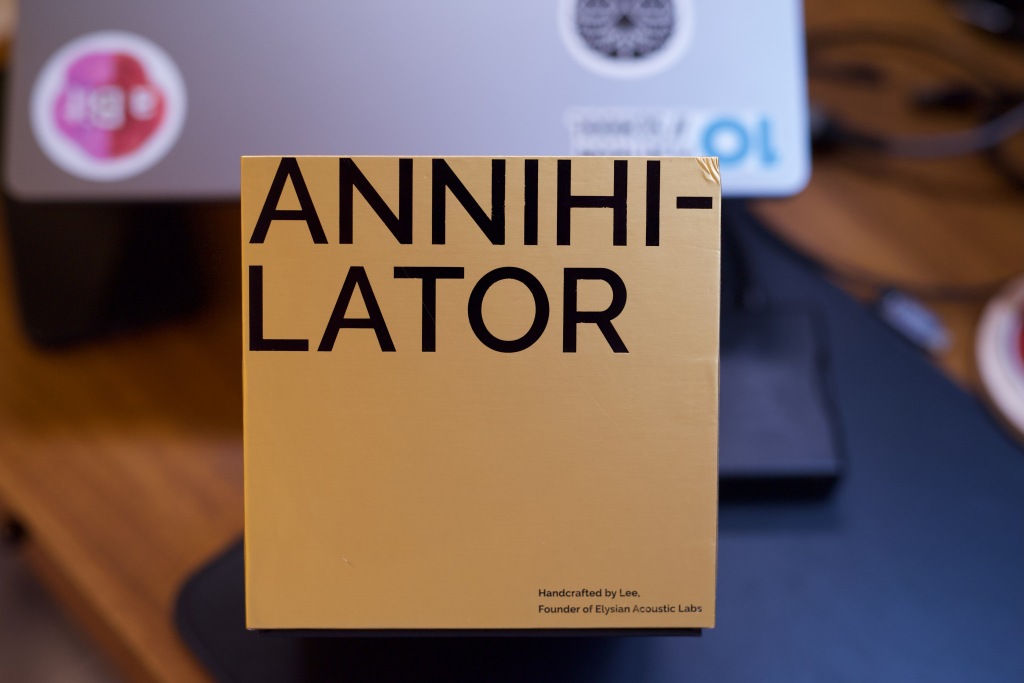
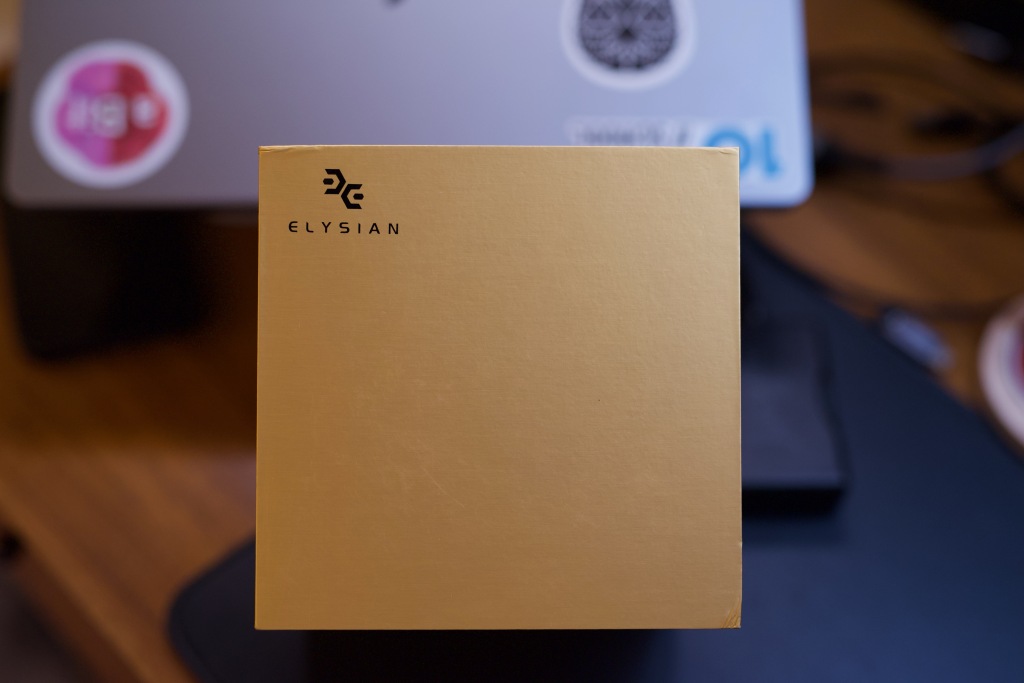
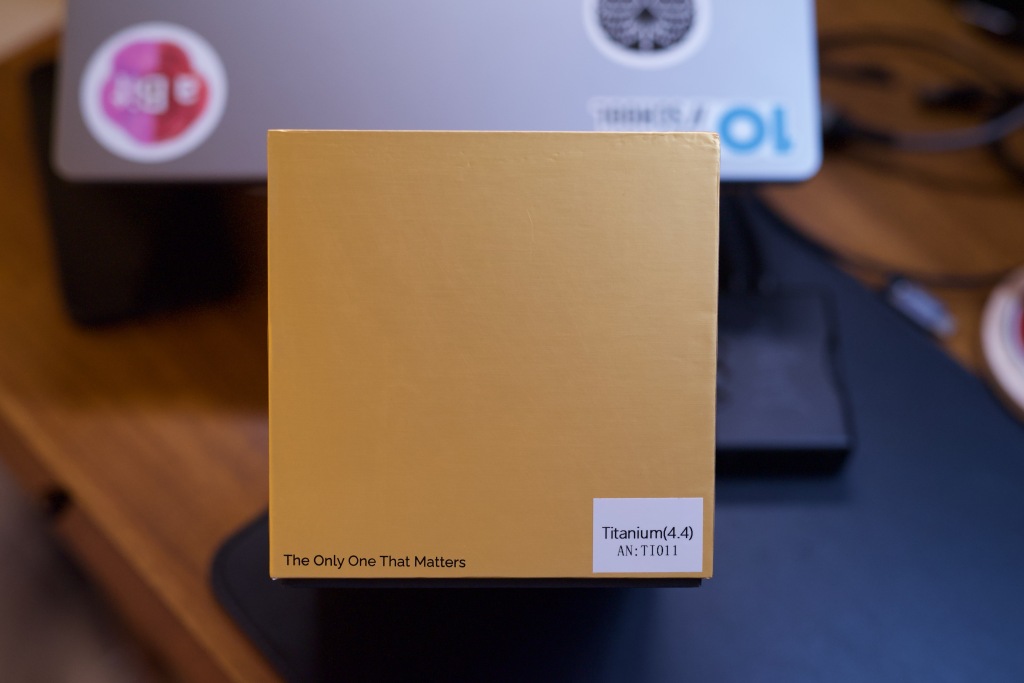
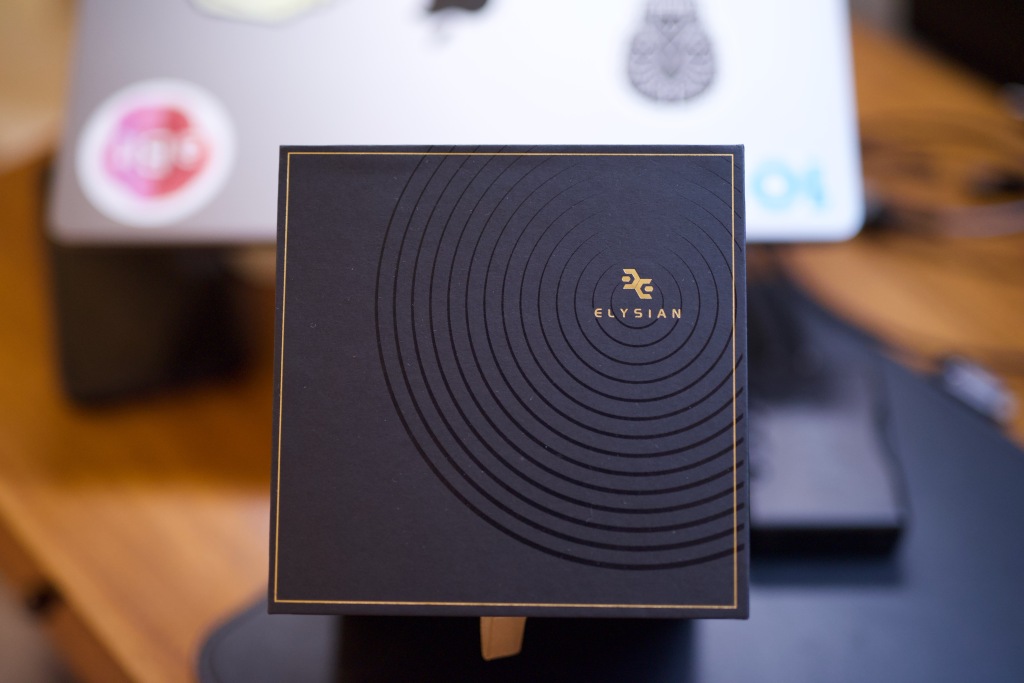
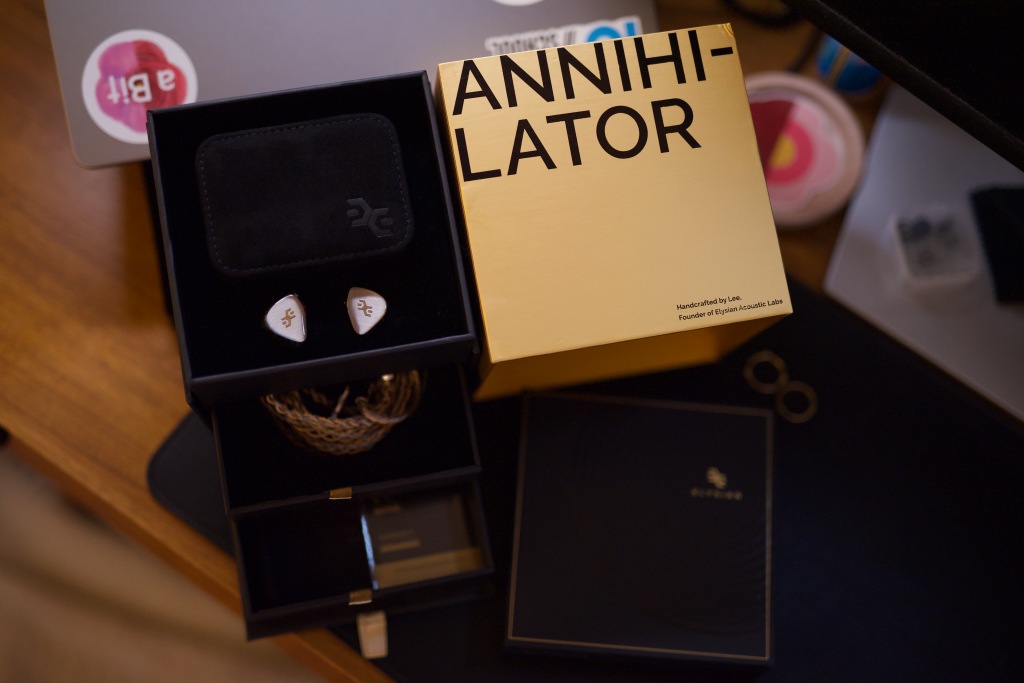
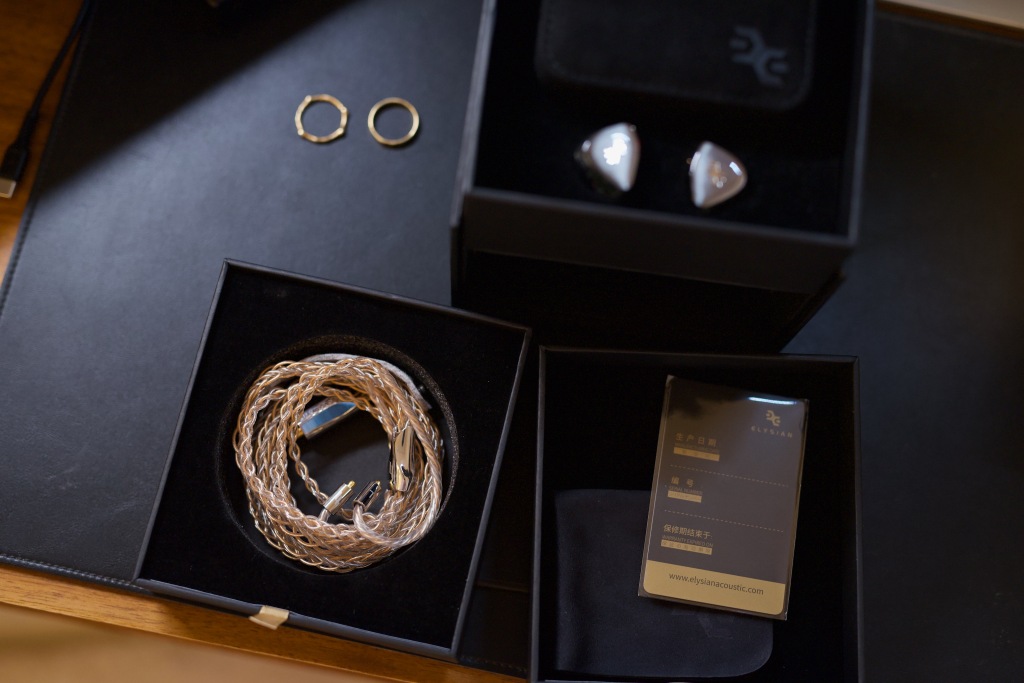
The unboxing experience of the Annihilator 2023 is extravagant.
The cubic box is enveloped in an arresting gold with "ANNIHI-LATOR" emblazoned across the face of the box in bold, all caps.
Printed on the bottom right it reads: "Handcrafted by Lee, Founder of Elysian Acoustics Labs", and there's one last inscription on the back, this time a bold proclamation: "The Only One That Matters".
Lee's flair for the dramatic is on full display with the Annihilator's packaging, and it's effective.
Sans the box cover, the unboxing experience is identical to the Diva's, only with more flair, more charisma.
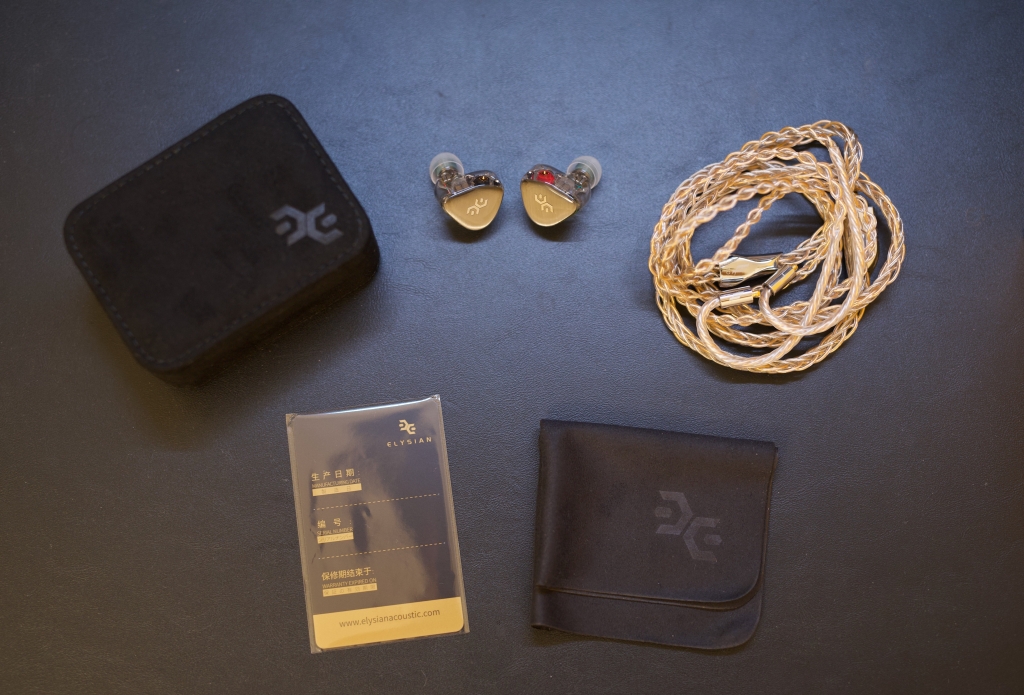
Inside the box is the following:
- A pair of Annihilators
- S/M/L SpinFit W1 ear tips
- Suede carry case
- Liquid Links Martini cable with a 4.4mm Pentaconn termination
- Microfiber cloth
- Card of authenticity
Comfort
The Annihilator shells and nozzles are on the larger side so those with smaller ear canals may experience difficulty finding a comfortable fit.Despite its larger size, the Annihilator shells are lightweight and have an ergonomic design which should help with the fit.
The stock SpinFit W1 tips have a grippy texture that helps them stay in place and create a secure seal. I'm able to wear the Annihilator for hours without discomfort, but this may not be the case for some listeners.
Fit is similar to: Elysian Diva 2023, Monarch MK2/MK3, and Blessing 2: Dusk.
Sources
I used the following sources during my review process:- MASS-Kobo 475 amp
- Chord Mojo 2
- MacBook Pro
The Annihilator is a little harder to drive than most IEMs. Despite this, I had no issues driving it on any of my sources.
I tested the Annihilator using lossless files from Qobuz, SpinFit W1 tips, and the stock Liquid Links Martini cable.
Sound Impressions
Lows
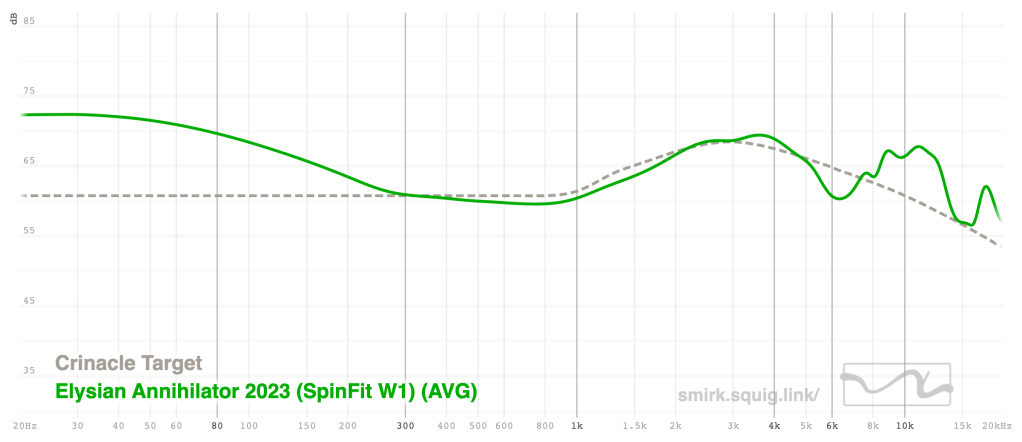
Measurements were taken on my personal IEC-711 clone coupler.
The frequency response of the Annihilator is an aggressive U-shape with a very pronounced mid and sub-bass that results in punchy lows.
The Annihilator's bass is quick and has a buzzy subwoofer-like effect with somewhat soft transient edges.
The bass is diffuse-sounding and has a large area of effect. Bass notes sound big and reverberate throughout the entire stage before quickly dissipating.
Although it’s engaging, the bass could use more finesse. It sounds as if it's on full tilt all the time and it lacks the resolution and definition found in top-tier bass responses.
The Annihilator's ability to texture bass isn't bad by any stretch but I found it lackluster for a $3000 IEM.
The bass has a decent weight, but it falls short of the sheer bass density and transient hardness of the IER-Z1R's bass. This isn't a knock since most IEMs fail to compete with the bass of the legendary Sony, but the Annihilator isn't most IEMs.
Overall, the Annihilator's bass goes for a quick, big punch and plays a complementary role to its midrange and treble. It's engaging, but it may be too much mid-bass for some listeners.
Mids
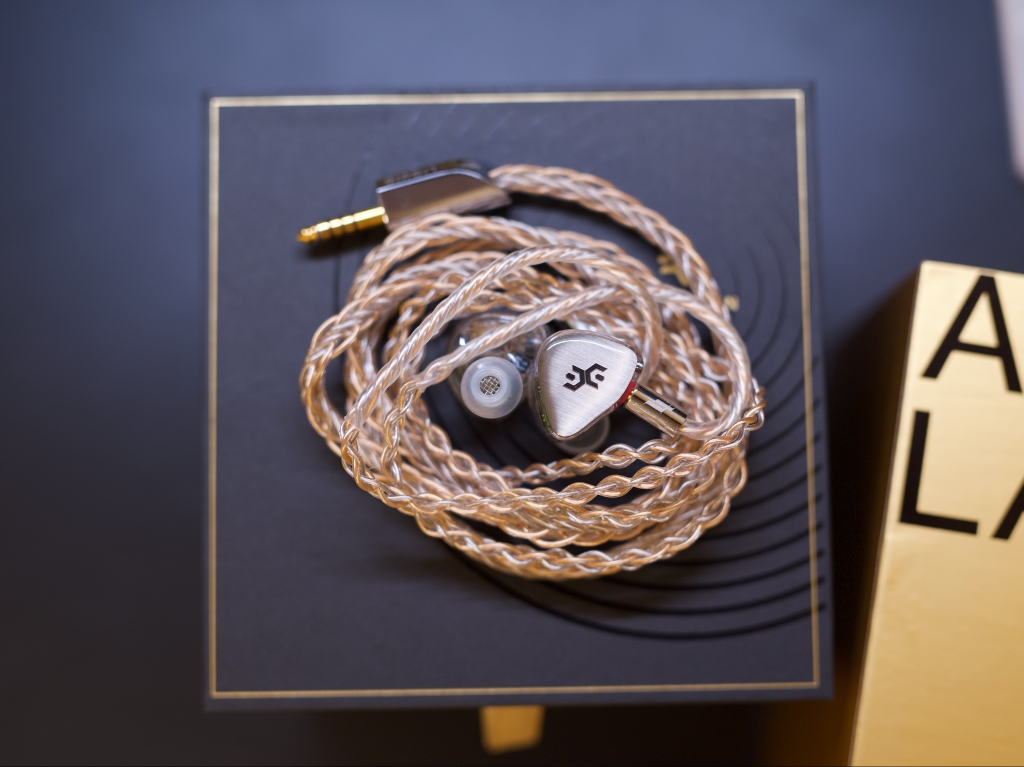
The Annihilator's midrange has a neutral-bright tonality with great clarity that comfortably bests the midrange resolution of the U12t, although the U12t does a slightly better job bringing out microdetails to the foreground.
I haven't listened to the Subtonic Storm or other contenders for the single-most resolving set period, but the Annihilator's clarity is top-tier and shouldn't leave anyone needing even more resolution.
The Annihilator's voicing is believable but ever-so-slightly raw and digital. There's a very subtle center skew in the vocal presentation that prevents it from being entirely accurate. I didn’t find this an issue though as it’s clear the Annihilator was never intended to be a reference-type IEM.
The female and male vocals are positioned forward. Female vocals can get aggressive and toe the line, but I can't say in earnest that I found them shouty on any track.
The forwardness of the midrange provides a nice balance between the aggressive mid-bass and elevated treble giving the Annihilator a slight W-shape. Considering how aggressive each section is, it's remarkable how well they interplay to provide a cohesive and engaging end result.
The Annihilator boasts a high clarity, exceptionally resolving midrange with a neutral-bright timbre.
Highs
If there’s one word that sums up the Annihilator’s treble, it’s "effortless." It's incredibly fast, and even the tiniest treble details flit in and out of existence without a single one going unaccounted for. The Annihilator’s treble is wonderfully extended and elevated, yet it never becomes sharp or piercing.Without hyperbole, the Annihilator possesses the most capable treble I've ever heard. Even during the most intensive, treble-heavy passages, the Annihilator performs as effortlessly as a world-class sprinter training at half-speed. It never seems to be under duress at any point.
It's not all praise for the Annihilator's treble though. Despite its abilities, the treble notes exhibit weightlessness and are lacking in sustain. It's almost too fast if there's such a thing.
Listening to the Annihilator's treble is undoubtedly an experience, even if it doesn't always sound natural. Even so, I think most listeners would accept this small cost in exchange for the world's best treble.
Detail and Imaging
The Annihilator's midrange and treble have superb clarity and resolution. The midrange is forward and very revealing while the treble presents all its minute details with ease. The bass is the only area where I think the Annihilator could use better definition and resolution.The Annihilator's soundstage is quite wide but has average height and depth. Imaging is pretty accurate but it's not a standout quality at $3000.
The Annihilator is easily out-imaged by the U12t and the new Symphonium Crimson which are significantly less expensive at $2000 and $1500, respectively.
Tonality
The Annihilator has a neutral-bright tonality that sounds very clean and coalesces nicely with the Annihilator's exceptional resolution.Despite its brightness, unlike other bright IEMs, the Annihilator avoids glare and sounding harsh or clinical.
Dynamics
The Annihilator has excellent dynamics that contribute to its aggressive and exciting sound. It rides large dynamic swings quickly and with ease.The Annihilator has all the components — a big bass, boosted treble, and huge dynamics — that makes it one of the most exciting IEMs on the market.
When all these elements converge at the same time on a track, it's fireworks.
Shortcomings
Here are a few shortcomings of the Annihilator:- Prohibitive cost.
- Bass definition and bass texturing could be better for its price.
- Lack of treble note weight and sustain.
- Average imaging for its price.
Intangibles
For all its celebrity, the Annihilator is hardly a perfect IEM. Despite its flaws, it has undeniable star power due to its peerless treble and allocation of strengths in high-impact areas.The Annihilator is big, bold, and loud. Sprinkle top-tier resolution and great tuning into the mix and you have a very compelling package.
In my opinion, no other IEM combines top-tier technicalities and a high engagement factor as effectively as the Annihilator.
Its combination of technique and fun is what makes the Annihilator intangibly great. Nothing sounds quite like it.
Comparisons
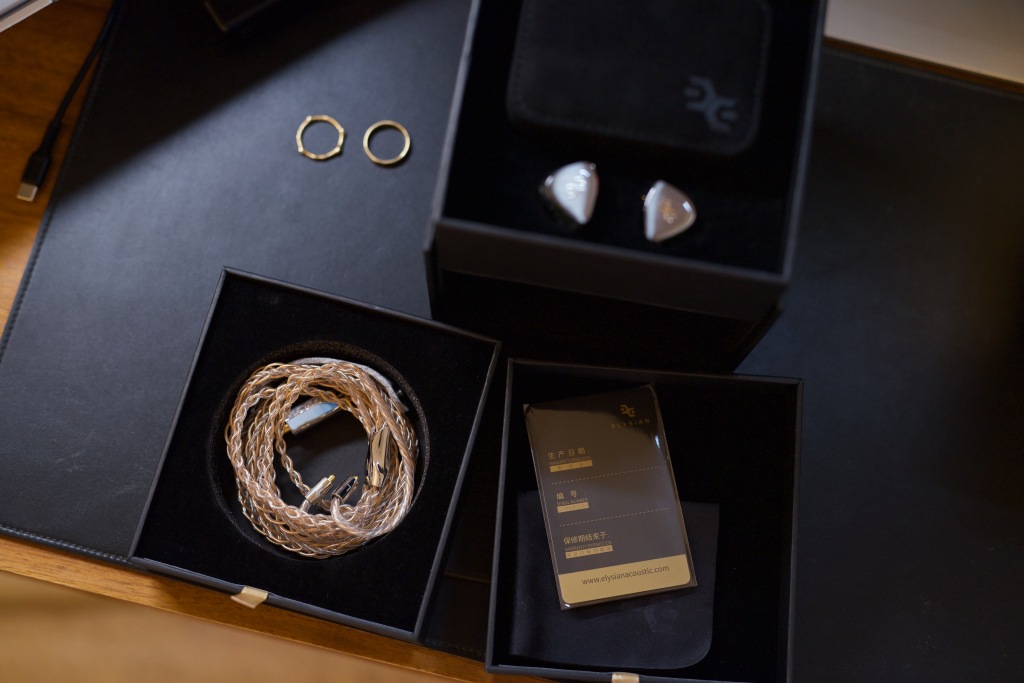
Annihilator vs. U12t
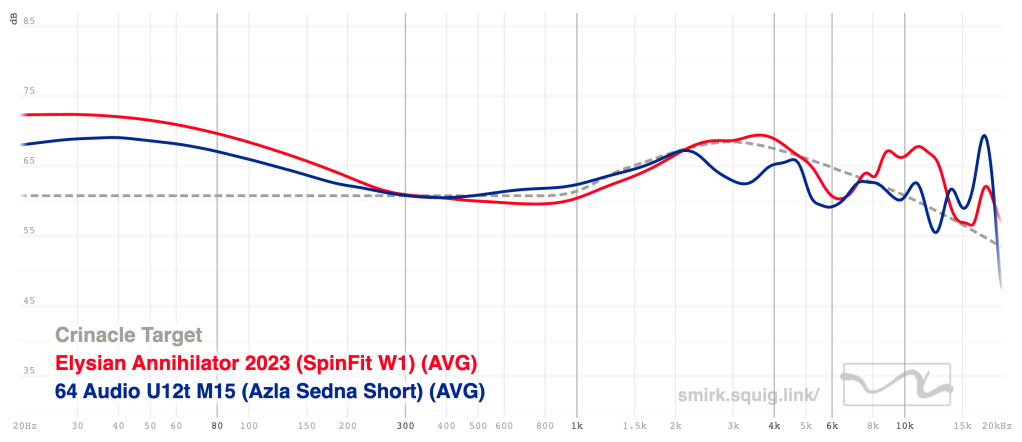
It's virtually a rite of passage for every TOTL contender to be pitted against the U12t. Let's see how the Annihilator stacks up.
The Annihilator's graph is an aggressive U, while the U12t's tuning is a bass-boosted neutral with an upper-mids scoop and an upper-treble peak.
The Annihilator has a neutral-bright tonality. The U12t's tonality is neutral-warm.
The first thing that jumps out is that the Annihilator is immediately higher-res. It is noticeably more clear in its voicing and across the frequency spectrum.
Both contenders have punchy bass, but bass texturing going to the U12t, even if it's lacking in bass realism due to its unnaturally short bass decay.
Vocals are somewhat recessed on the U12t but are smoother and more refined than the Annihilator's. The Annihilator's vocals are notably more resolving and clear.
The Annihilator's boosted treble is extremely quick and sounds pleasant despite its brightness. The U12t's treble has a more natural note weight and decay than the Annihilator's but has an upper peak that can become bothersome.
The Annihilator's presentation of music can be seen as aggressive, engaging, and opinionated, whereas the U12t's aims to create a more faithful reproduction of a recording.
Annihilator vs. Diva 2023
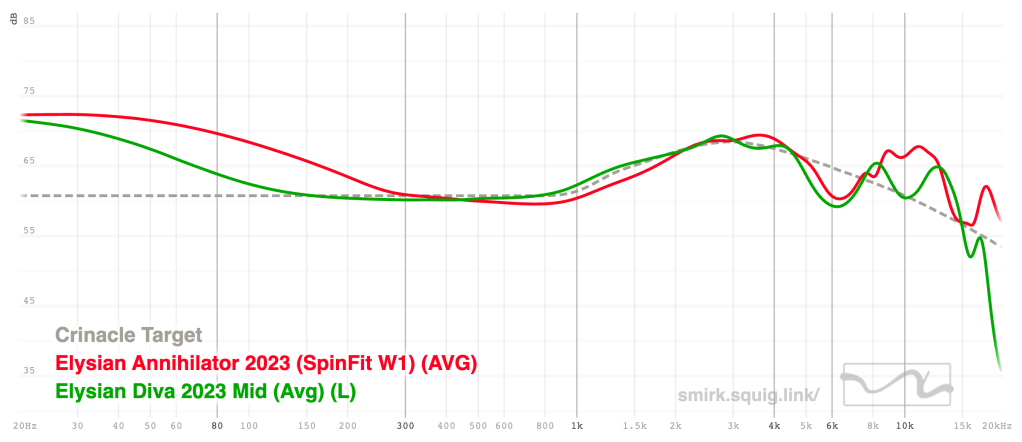
Next up we have a battle between Elysian siblings.
The younger sibling Diva has a bass-boosted neutral tuning with an upper-treble roll-off versus the Annihilator's aforementioned U shape.
The Diva has a sweet, pigmented, and at times, euphoric tonality, whereas the Annihilator's is neutral-bright.
The Diva's bass has a notable sub-bass tilt which is in stark contrast to the Annihilator's more mid-bass-focused tuning.
The bass quality is decent on both sets, but are lacking somewhat in transients, density, and texturing for their respective price ranges.
The Diva's strength is its vocal presentation which is lush, pigmented, and smooth, if ultimately lacking in microdetails and resolution. The Annihilator's vocals are slightly raw in comparison but are significantly more resolving and clear.
The Diva has a fairly linear treble with a safe tuning, though it does roll off significantly in the upper treble. Although the Diva's treble doesn't do anything wrong, it's outclassed by the superior speed, extension, and resolution of the Annihilator's treble.
The Diva and Annihilator have many differences, but they share an Elysian "house" engagement factor. No one will mistake them for reference sets, but they're undeniably moving.
Annihilator vs. Monarch MKIII
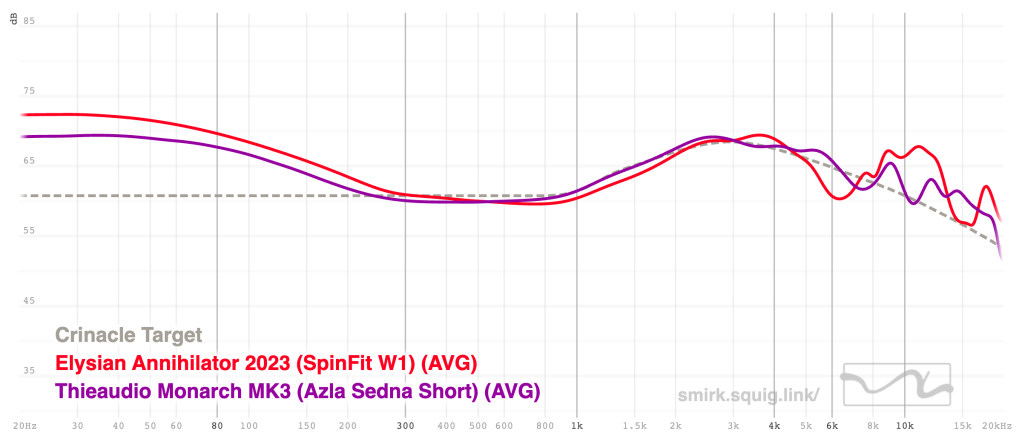
The successor to the immensely popular Monarch MK2, the Monarch MK3 is one of the newest kilobuck entries into an increasingly competitive market.
The Monarch MK3 sports a U-shaped tuning like the Annihilator and possesses great technicalities and treble extension.
Despite suffering from some mid-bass transient bloat, the Monarch has better bass texturing than the Annihilator.
The Annihilator has a slight edge in vocal clarity, but the Monarch's isn't far behind and presents a more refined vocal experience overall. Vocals on both sets present forward, with the Monarch possessing a pigmentation like the Diva's.
Although the Monarch has a well-extended treble, it suffers from some treble tizziness and an unnatural sense of treble detail. Microdetails can sound a bit forced which is in stark contrast to the effortlessness of the Annihilator's treble.
Soundstage size is competitive between the two sets, but the Monarch has a slight edge in imaging precision.
For a third of the Annihilator's price, the Monarch MK3 is a compelling product that represents great value in a rising IEM market.
Annihilator vs. Symphonium Crimson
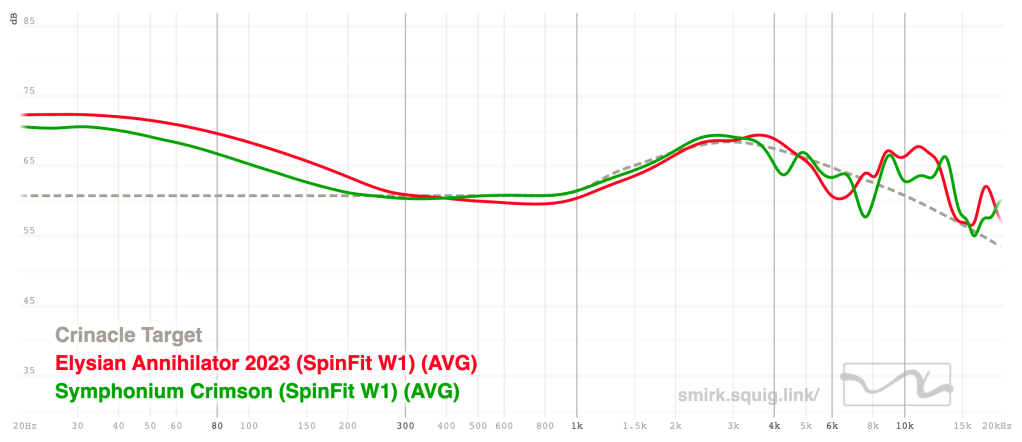
One of the newest entries into the $1600 bracket, Symphonium's sophomore offering improves upon its already well-received Helios.
Crimson is its name, and like the Annihilator, it possesses a U-shaped tuning.
You'll notice that the Annihilator's bass graphs more elevated, but in practice, the Crimson's bass has a more satisfying and pronounced slam.
The Crimson has a superb bass by virtue of its well-defined transients, substantial heft, and great texturing. It also demonstrates more nuance than the Annihilator's, filling a room or showing restraint as a recording requires.
The Annihilator's vocals present more forward than the Crimson's and offer superior clarity and resolution. Crimson's vocals are decent and sound more integrated into the mix.
Crimson's treble is well-extended but can get a little spicy because of its upper-treble elevation. I hear occasional tizziness, though this may depend on the sources and ear tips used.
The Annihilator's treble is also elevated, but it manages to sound pleasant at all times and avoids the glare and shimmer present in the Crimson's.
If the Annihilator's star quality is its treble, the Crimson's is its expansive soundstage and impeccable imaging.
Possessing a soundstage like the IER-Z1R's and imaging chops like the U12t's, the Annihilator, and most other IEMs, are outclassed by the Crimson in these areas.
The Annihilator and Crimson are two IEMs that trade heavy blows. The "better" IEM will depend heavily on the listener's preferences.
Conclusion
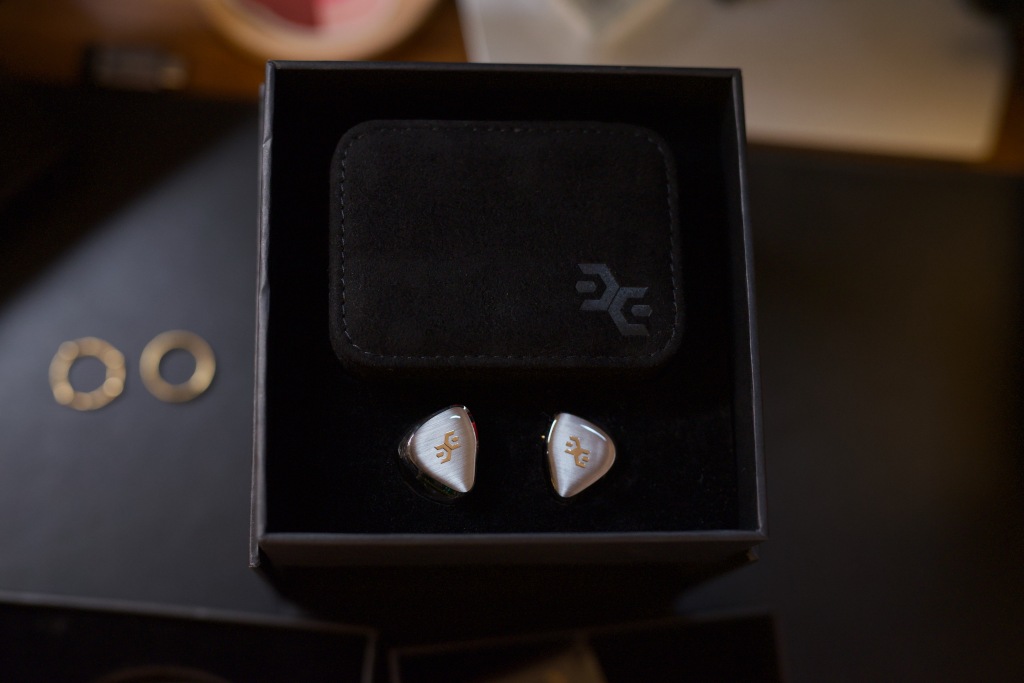
Priced at an eye-watering $3000 and plagued by lengthy production times, the Annihilator 2023 is an IEM that has a lot of promise to fulfill.
So, is it worth its astronomical price tag and agonizing wait?
I'll put it this way. If you strip the Annihilator of the shimmering robe of hype and cult-like status, what remains is a highly technical, very engaging monitor equipped with the world's finest treble.
You'd be hard-pressed to find a single IEM at or below $3000 that outright surpasses the Annihilator 2023.
Last edited:
freeryder05
100+ Head-Fier
Pros: Midbass Texturing
Thick and Precise Mids
Treble Presentation
Tuning
Detail and Clarity
Thick and Precise Mids
Treble Presentation
Tuning
Detail and Clarity
Cons: Harder to drive than most IEMs
Weird connnectors that are not commonly used
Cable is very heavy
Shell is quite large
Sub bass could use more slam
Weird connnectors that are not commonly used
Cable is very heavy
Shell is quite large
Sub bass could use more slam


I recently got my hands on the Elysian Annihilator 2023. I want to thank my friend for letting me test them, measure them and compare them tomy personal pair of Annihilator 2021s. Elysian needs no introduction. The Annihilator quickly jumped to the top of many reviewers charts for the best treble response in an IEM. It is incisive, natural and never piercing. Many reviewers have praised the Annihilator for impressive detail retrieval, treble response and clarity. Its biggest downside is bass, but I think this is mostly nitpicking a top 3 IEM in the entire world.
Notes: All reviewing is done using Questyle M15 dongle, Apple Music Lossless or Local FLAC files. Driving this IEM can be pretty tough. My Q5k and apple dongle weren’t really doing it justice. I threw it on my tube amp, but it really was not a good pairing. The M15 was the best so that is how I reviewed the unit.
Anni 2021 vs Anni 2023




Both of these IEMs are absolutely stellar. They are both easy 5 out of 5 IEMs. I like to think I am fairly picky, but this is an easy decision for me. There are differences to both, but one is not necessarily an upgrade to the other. The biggest difference between them is the bass response. The bass on 2023 is more midbass focused leaning to meatier mids and a nice weight behind drums, bass guitar, cello, trombone and other lower frequency instruments. For the most part, the rest of the FR remains unchanged.
On a technical point, the 2023 feels like it might be a hair more resolving and the treble might be a tough more reigned in on some of the best treble in the world. The difference may be .1%, but worth noting.
The build on 2023 definitely feels like an upgrade. The nozzle is a beautiful gold nozzle with a nice filter on the end. 2021 is more of the classic pseudo custom fit with a nozzle more like the Blessing 2. The lack of filter could be worrying to some, but it doesn’t really affect me. Shell size and comfort are identical to my ears, but the more refined look of the 2023 really stands out.
Sound:
Bass: I have mentioned this already, but the Annihilator 2023 is focused in the midbass regions to help give meat to the mids and bring forward a very natural timbre to the low end. Bass guitars, cellos, trombones, snares and toms all sound lucious and full. Songs like Spoon By Dave Matthews Band, Cumberland Blues by the Grateful Dead and The Chicken by Brian Brohmberg all absolutely shine. The textures are perfectly executed. This is what mid bass is and what it should sound like. I can feel the finger picking of Stefan Lessard and the plcuking of Phil Lesh so clearly it’s hard not to groove along. Bass players like Brian Brohmberg, Marcus MIller and Jaco Pastorius are heavily featured in my music and this is the best I have heard them sound since my Verite Closed. I never thought of myself as a timbre head, but I think this does it for me.
Sub bass is a bit of an issue though. Songs like How you Like That by BLACKPiNK or Neon Medusa by the Midnight don’t exactly slam, but are passable. If you like techno or heavy EDM, I don’t think this is a great fit for you. The bass is rumbly, but not exactly slammy. (The bass on the 2021 is even lighter). If you want to truly slam and rumble, the answer is still IE900 to my ears. I will give this a 7/10 only because the sub bass is a bit loose and not as slammy as other options I have tested despite the amazing midbass response leading to insane texturing.
Mids: I might break my arm jerking off the Annihilator, but Lee did something amazing here. I love the mids on this IEM. They feel heavy and powerful without ever leaving me wanting more. The textures are natural, the instrumentations are separated well and the vocal timbre is just perfect to my ears. Violins, guitar strumming, male vocals, banjos, trumpets you name it, are all quick with perfect decay. This section is short because there are no issues here. The mids here are perfect. Bar none, this is the best I have heard. My A12t comes close, but fails in the upper mids. IE900 comes close, but requires a ton of EQ to get there. Meteor has so much going for it, but in terms of detail retrieval from busy sections, it doesn’t keep up with something like Annihilator. This is 10/10 mids. I will give it no fault at all.
Treble: The scale has been broken because this is where every IEM fails. Tuning treble is very difficult because affordable measuring equipment does not accurately measure treble. The flaws within the commonly used 711c couplers compared to the new 5128, and its other variants, have shown that treble has been tuned basically by ear since inception. Only a very select few have done it right. The Helios is the most linear of an IEM I have owned. It is incisive, but never fatiguing. It has shine and sparkle, but the Annihilator would be the next step.
I would not call myself a treble enjoyer on a typical day. Flutes, harmonicas, rides and cymbals are usually things I avoid. I love bluegrass so Banjo twang and higher register guitar is something I do appreciate (Please check out Billy Strings for the best bluegrass since The Stanley Brothers). I would call the Annihilator the most aggressive treble I have ever heard, but there’s something magical about it. It’s forward, it’s in your face, but it never hits sibilant. It shines like the sun, but never gets those sibilant spikes that I got on IEMs like Mest Mkii, A12t / U12t and a ton of other TOTLs. The clarity, decay and speed of the treble makes all the cymbal hits crystal clear helping to add air to the presentation. The treble’s aggressive tendencies play into the hands of extra clarity and detail. Opening up the higher frequencies allows it to project out of head images. This is 10/10 treble and I would give it more if I could. Pure magic here.
Imaging: I have never really had the out of body experience that some people claim to have with Andromeda or other IEMs known for staging. IEM staging is mostly a meme. If it can project any sort of stage width or height it’s in the top percentile of IEMs. Annihilator presents the 2nd largest stage I have heard. A12t is still the largest, but lacks the clarity and detail that comes with the Annihilator. The stage width and depth is on par with the Mest Mkii but lacks the beautiful tuning of the Annihilator. The strength of the imaging and technical prowess of the Annihilator 2023 is in the detail retrieval. You can hear studio easter eggs, like birds cawing on Sturgill Simpson’s “Call to Arms.” On an industrial post rock track called Reitschule by Do Make Say Think, the sounds of people muttering, outside noises and tip top cymbals add more busyness to a track that I have heard thousands of times. I hear new things every day I listen to the Annihilator and I can’t wait to continue exploring even though I am a lowly Annihilator 2021 owner.
TLDR: This is probably the best IEM in the world. There are other options that are less flavored, but equally technically skilled, such as the Subtonic Storm, but for my listening, the Annihilator hits all my boxes. It has amazing mid bass to mid texturing and timbre. The treble adds so much air and clarity that it’s pretty scary to think this is in my head. I can find no flaw in this IEM and is worth every cent and more. I hope one day to try the Subtonic Storm for more than a small demo session as it will be a true battle of the gods.
nihalsharma
Great Review.
IMO Odin, U12t are great IEMs but don't get labelled as the best IEMs. If you have any comparisons with the Jewel, XE6, Trailli etc. then I think will help someone better decide.
IMO Odin, U12t are great IEMs but don't get labelled as the best IEMs. If you have any comparisons with the Jewel, XE6, Trailli etc. then I think will help someone better decide.
freeryder05
@nihalsharma Sorry I just saw this. From my personal perspective, I would take the U12t, Odin, Helios, Mest Mkii over the XE6, Jewel and Trailli. The latter 3 just don't compare to Anni in any shape or form, in my opinion.
Shape77
I've ordered them after tried at London CanJam, they're absolutely stunning!

